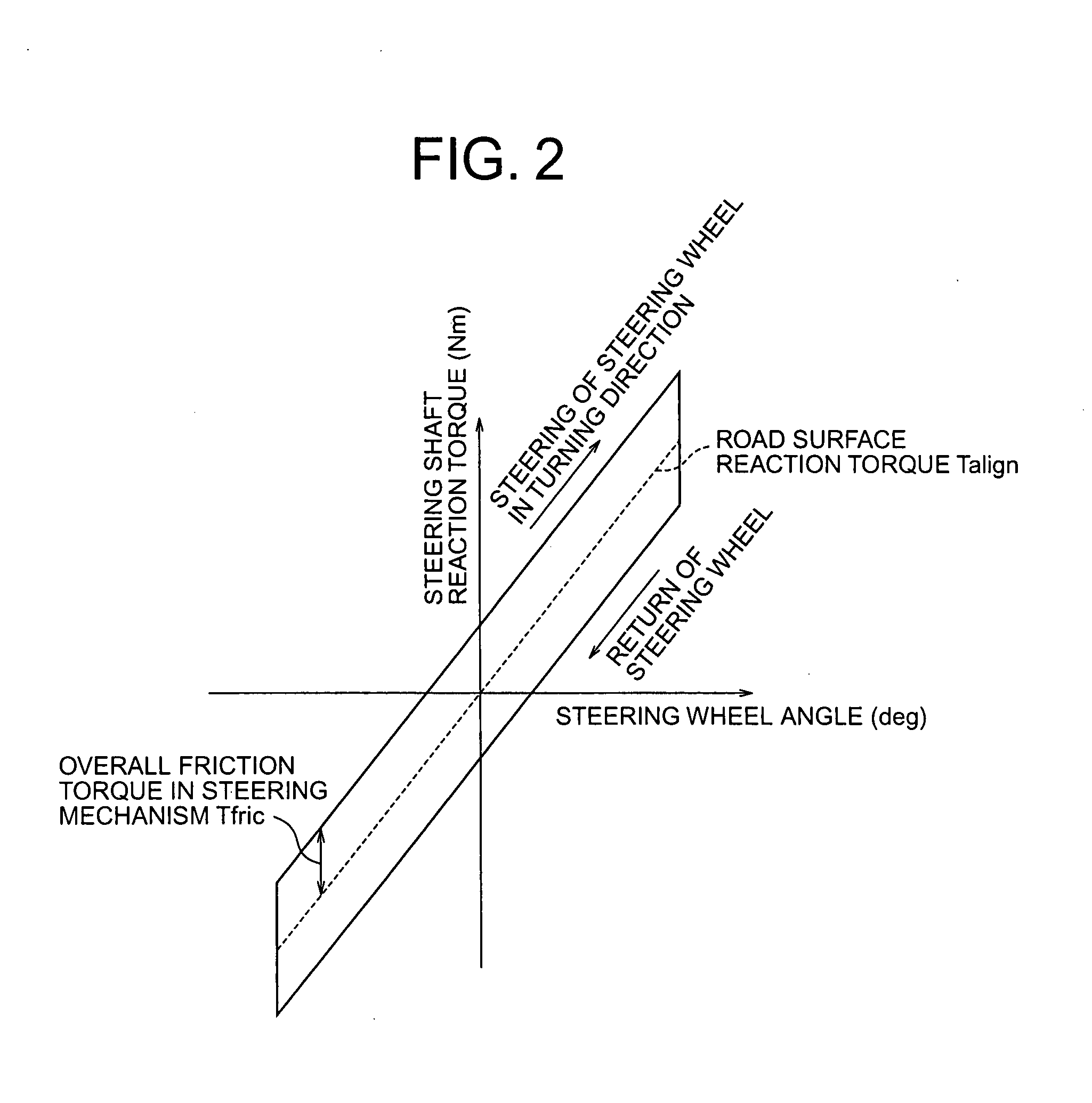Vehicular steering apparatus
a technology of steering apparatus and steering shaft, which is applied in the direction of steering initiation, underwater equipment, instruments, etc., can solve the problems of deterioration of steering feeling, small reaction torque on the road surface, and inability to improve steering feeling, so as to achieve constant improvement of steering feeling and reduce cost
- Summary
- Abstract
- Description
- Claims
- Application Information
AI Technical Summary
Benefits of technology
Problems solved by technology
Method used
Image
Examples
first embodiment
[0035]FIG. 1 is a schematic diagram showing a steering mechanism 1 of a vehicular steering apparatus according to a first embodiment of the present invention.
[0036]Referring to FIG. 1, a steering mechanism 1 has a steering wheel 2, a steering shaft 3, a steering gearbox 4, a steering wheel angle detector 5 (i.e., steering wheel angle detecting means), a torque sensor 6 (i.e., steering torque detecting means), an assist motor 7 (i.e., motor), a rack-and-pinion mechanism 8, tires 9 (i.e., wheels), an electric power steering (EPS) control means 10 (i.e., target current calculating means) (hereinafter, abbreviated as “the control means 10”), a vehicle speed detector 11 (i.e., vehicle speed detecting means), and a state quantity detector 12 (i.e., steering shaft reaction torque detecting means and road surface reaction torque detecting means).
[0037]The steering wheel 2, which is steered by a driver of an automobile, is coupled to one end of the steering shaft 3. The steering wheel 2 is f...
second embodiment
[0102]In the foregoing first embodiment of the present invention, the road surface reaction torque signal Talign(s) and the steering shaft reaction torque signal Ttran(s) have been described as signals obtained from the state quantity detector 12. However, the present invention is not limited to this configuration. That is, those signals may be obtained through calculation from various signals.
[0103]In a second embodiment of the present invention, components identical to those of the first embodiment of the present invention are denoted by the same reference symbols accompanied with “A” and will not be described in detail.
[0104]FIG. 10 is a functional block diagram showing an essential part of a control means 10A according to the second embodiment of the present invention.
[0105]Referring to FIG. 10, the control means 10A has a normative torque gradient value calculating portion 30, a steering wheel angle detecting portion 31, a friction torque calculating portion 32 (i.e., friction ...
third embodiment
[0127]According to the description of the foregoing first embodiment of the present invention and the foregoing second embodiment of the present invention, all the steering wheel angles θ are subjected to friction compensation as shown in FIG. 8. However, the overall friction torque Tfric may be sufficiently compensated for with the assist map compensation torque map(s) output by the assist map compensation portion 24 in a region in which the road surface reaction torque Talign is large. In this region, therefore, there is a problem in that the assist map compensation portion 24 and the friction compensation portion 28 interfere with each other.
[0128]Thus, it is desirable to variably set the magnitude of the friction compensation torque fric(s) based on the magnitude of the road surface reaction torque Talign.
[0129]A processing of variably setting the friction compensation torque fric(s) using the road surface reaction torque Talign will be described hereinafter.
[0130]In a third emb...
PUM
 Login to View More
Login to View More Abstract
Description
Claims
Application Information
 Login to View More
Login to View More - Generate Ideas
- Intellectual Property
- Life Sciences
- Materials
- Tech Scout
- Unparalleled Data Quality
- Higher Quality Content
- 60% Fewer Hallucinations
Browse by: Latest US Patents, China's latest patents, Technical Efficacy Thesaurus, Application Domain, Technology Topic, Popular Technical Reports.
© 2025 PatSnap. All rights reserved.Legal|Privacy policy|Modern Slavery Act Transparency Statement|Sitemap|About US| Contact US: help@patsnap.com



